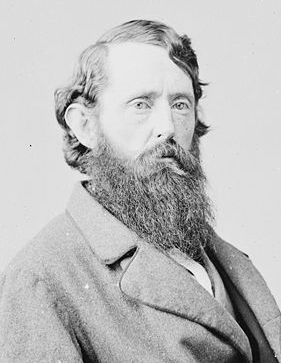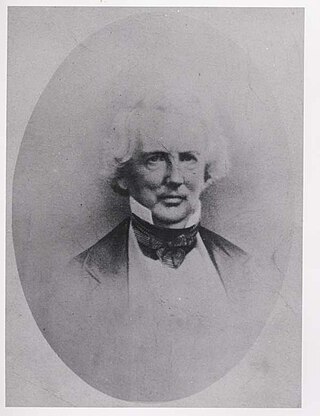
The Confederate States of America (CSA), commonly referred to as the Confederate States (C.S.), the Confederacy, or the South, was an unrecognized breakaway republic in the Southern United States that existed from February 8, 1861, to May 9, 1865. The Confederacy comprised eleven U.S. states that declared secession and warred against the United States during the American Civil War. The states were South Carolina, Mississippi, Florida, Alabama, Georgia, Louisiana, Texas, Virginia, Arkansas, Tennessee, and North Carolina.

The 1860 United States presidential election was the 19th quadrennial presidential election, held on Tuesday, November 6, 1860. In a four-way contest, the Republican Party ticket of Abraham Lincoln and Hannibal Hamlin won a national popular plurality, a popular majority in the North where states already had abolished slavery, and a national electoral majority comprising only Northern electoral votes. Lincoln's election thus served as the main catalyst of the states that would become the Confederacy seceding from the Union. This marked the first time that a Republican was elected president. It was also the first presidential election in which both major party candidates were registered in the same home state; the others have been in 1904, 1920, 1940, 1944, and 2016.

The Wade–Davis Bill of 1864 (H.R. 244) was a bill "to guarantee to certain States whose governments have been usurped or overthrown a republican form of government," proposed for the Reconstruction of the South. In opposition to President Abraham Lincoln's more lenient ten percent plan, the bill made re-admittance to the Union for former Confederate states contingent on a majority in each ex-Confederate state to take the Ironclad Oath to the effect they had never in the past supported the Confederacy. The bill passed both houses of Congress on July 2, 1864, but was pocket vetoed by Lincoln and never took effect. The Radical Republicans were outraged that Lincoln did not sign the bill. Lincoln wanted to mend the Union by carrying out the ten percent plan. He believed it would be too difficult to repair all of the ties within the Union if the Wade–Davis bill passed.

In the context of the American Civil War (1861–65), the border states were slave states that did not secede from the Union. They were Delaware, Maryland, Kentucky, and Missouri, and after 1863, the new state of West Virginia. To their north they bordered free states of the Union, and all but Delaware bordered slave states of the Confederacy to their south.

In the United States before 1865, a slave state was a state in which slavery and the internal or domestic slave trade were legal, while a free state was one in which they were prohibited. Between 1812 and 1850, it was considered by the slave states to be politically imperative that the number of free states not exceed the number of slave states, so new states were admitted in slave–free pairs. There were, nonetheless, some slaves in most free states up to the 1840 census, and the Fugitive Slave Clause of the U.S. Constitution, as implemented by the Fugitive Slave Act of 1793 and the Fugitive Slave Act of 1850, provided that a slave did not become free by entering a free state and must be returned to his or her owner.

The Constitutional Union Party was a United States third party active during the 1860 elections. It consisted of conservative former Whigs, largely from the Southern United States, who wanted to avoid secession over the slavery issue and refused to join either the Republican Party or the Democratic Party. The Constitutional Union Party campaigned on a simple platform "to recognize no political principle other than the Constitution of the country, the Union of the states, and the Enforcement of the Laws".

Francis Preston Blair Jr. was a United States Senator, a United States Congressman and a Union Major General during the Civil War. He represented Missouri in both the House of Representatives and the Senate, and was active in preventing the State of Missouri from being absorbed into the Confederacy at the beginning of the Civil War.

Benjamin Gratz Brown was an American politician. He was a U.S. Senator, the 20th Governor of Missouri, and the Liberal Republican and Democratic Party vice presidential candidate in the presidential election of 1872.

The Camp Jackson affair, also known as the Camp Jackson massacre, occurred during the American Civil War on May 10, 1861, when a volunteer Union Army regiment captured a unit of secessionists at Camp Jackson, outside the city of St. Louis, in the divided slave state of Missouri.

The 37th United States Congress was a meeting of the legislative branch of the United States federal government, consisting of the United States Senate and the United States House of Representatives. It met in Washington, D.C., from March 4, 1861, to March 4, 1863, during the first two years of Abraham Lincoln's presidency. The apportionment of seats in the House of Representatives was based on the 1850 United States census.

Hamilton Rowan Gamble was an American jurist and politician who served as the Chief Justice of the Missouri Supreme Court at the time of the Dred Scott case in 1852. Although his colleagues voted to overturn the 28-year precedent in Missouri of "once free always free," Gamble wrote a dissenting opinion. During the American Civil War, he was appointed as the Governor of Missouri by a Constitutional Convention after Union forces captured the state capital at Jefferson City and deposed the elected governor, Claiborne Jackson.

The Virginia Conventions have been the assemblies of delegates elected for the purpose of establishing constitutions of fundamental law for the Commonwealth of Virginia superior to General Assembly legislation. Their constitutions and subsequent amendments span four centuries across the territory of modern-day Virginia, West Virginia and Kentucky.
The ten percent plan, formally the Proclamation of Amnesty and Reconstruction, was a United States presidential proclamation issued on December 8, 1863, by United States President Abraham Lincoln, during the American Civil War. By this point in the war, the Union Army had pushed the Confederate Army out of several regions of the South, and some Confederate states were ready to have their governments rebuilt. Lincoln's plan established a process through which this postwar reconstruction could come about.
The Unionist Party, later known as the Unconditional Union Party in the border states, was a political party in the United States started after the Compromise of 1850 to define politicians who supported the Compromise. It was used primarily as a label by politicians who did not want to affiliate with the Republicans, or wished to win over anti-secession Democrats. Members included Southern Democrats who were loyal to the Union as well as elements of the old Whig Party and other factions opposed to a separate Southern Confederacy.

During the American Civil War, Missouri was a hotly contested border state populated by both Union and Confederate sympathizers. It sent armies, generals, and supplies to both sides, maintained dual governments, and endured a bloody neighbor-against-neighbor intrastate war within the larger national war.
The Missouri Constitutional Convention of 1861–1863 was a constitutional convention held in the state of Missouri during the American Civil War. The convention was elected in early 1861, and voted against secession. When open fighting broke out between Pro-Confederate governor Claiborne Fox Jackson and Union authorities, and Union forces occupied the state capital, the convention formed a provisional state government, and functioned as a quasi-legislature for several years. The convention never did produce a new constitution; that task was delegated to a new convention, elected in 1864.

The presidency of Abraham Lincoln began on March 4, 1861, when Abraham Lincoln was inaugurated as the 16th president of the United States, and ended upon his assassination and death on April 15, 1865, 42 days into his second term. Lincoln was the first member of the recently established Republican Party elected to the presidency. Lincoln successfully presided over the Union victory in the American Civil War, which dominated his presidency and resulted in the end of slavery.

The Frémont Emancipation was part of a military proclamation issued by Major General John C. Frémont (1813–1890) on August 30, 1861, in St. Louis, Missouri during the early months of the American Civil War. The proclamation placed the state of Missouri under martial law and decreed that all property of those bearing arms in rebellion would be confiscated, including slaves, and that confiscated slaves would subsequently be declared free. It also imposed capital punishment for those in rebellion against the federal government.

The Virginia Secession Convention of 1861 was called in the state capital of Richmond to determine whether Virginia would secede from the United States, govern the state during a state of emergency, and write a new Constitution for Virginia, which was subsequently voted down in a referendum under the Confederate Government.

The 1861 Maryland gubernatorial election took place on November 6, 1861. It was held amid the early phases of the American Civil War and was contested between the Unionist Party's Augustus Bradford and the Democratic Party's Benjamin Chew Howard. Bradford supported the maintenance of the Union while Howard advocated for a peace treaty with the Confederacy. Concerned about pro-secession elements in the state, the federal government sent troops to supervise the vote and ordered electors to take an oath of loyalty to the Union. The election was won by Bradford with 68.8% of the votes.



















